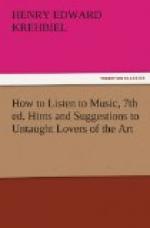[Sidenote: The sonata.]
That Scarlatti also pointed the way to the modern sonata, I have already said. The history of the sonata, as the term is now understood, ends with Beethoven. Many sonatas have been written since the last one of that great master, but not a word has been added to his proclamation. He stands, therefore, as a perfect exemplar of the second period in the scheme which we have adopted for the study of pianoforte music and playing. In a general way a sonata may be described as a composition of four movements, contrasted in mood, tempo, sentiment, and character, but connected by that spiritual bond of which mention was made in our study of the symphony. In short, a sonata is a symphony for a solo instrument.
[Sidenote: Haydn.]
When it came into being it was little else than a convenient formula for the expression of musical beauty. Haydn, who perfected it on its formal side, left it that and nothing more. Mozart poured the vessel full of beauty, but Beethoven breathed the breath of a new life into it. An old writer tells us of Haydn that he was wont to say that the whole art of composing consisted in taking up a subject and pursuing it. Having invented his theme, he would begin by choosing the keys through which he wished to make it pass.
“His exquisite feeling gave him a perfect knowledge of the greater or less degree of effect which one chord produces in succeeding another, and he afterward imagined a little romance which might furnish him with sentiments and colors.”
[Sidenote: Beethoven.]
[Sidenote: Mozart’s manner of playing.]
Beethoven began with the sentiment and worked from it outwardly, modifying the form when it became necessary to do so, in order to obtain complete and perfect utterance. He made spirit rise superior to matter. This must be borne in mind when comparing the technique of the previous period with that of which I have made Beethoven the representative. In the little that we are privileged to read of Mozart’s style of playing, we see only a reflex of the players who went before him, saving as it was permeated by the warmth which went out from his own genial personality. His manipulation of the keys had the quietness and smoothness that were praised in Bach and Handel.
“Delicacy and taste,” says Kullak, “with his lifting of the entire technique to the spiritual aspiration of the idea, elevate him as a virtuoso to a height unanimously conceded by the public, by connoisseurs, and by artists capable of judging. Clementi declared that he had never heard any one play so soulfully and charmfully as Mozart; Dittersdorf finds art and taste combined in his playing; Haydn asseverated with tears that Mozart’s playing he could never forget, for it touched the heart. His staccato is said to have possessed a peculiarly brilliant charm.”
[Sidenote: Clementi.]




